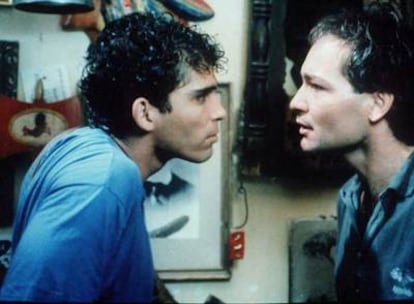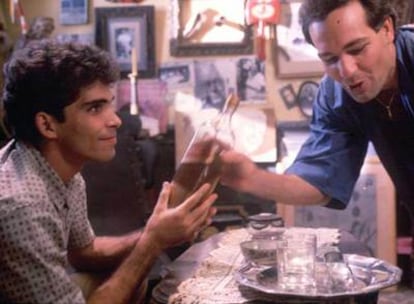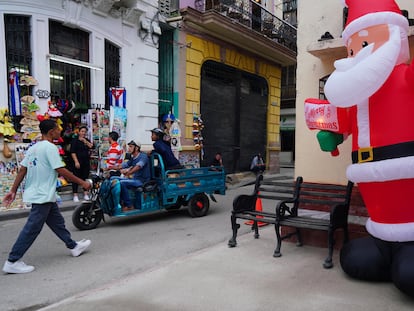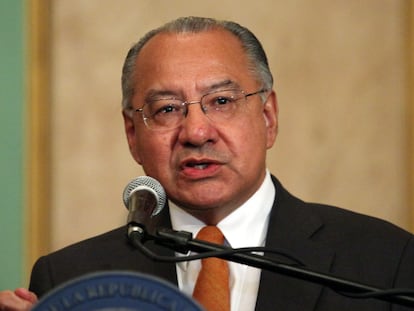Cuba looks at itself in the mirror, 30 years after ‘Strawberry and Chocolate’
Three decades after its release, the subjects discussed in the film that opened the minds of Cubans to homosexual relationships continue to spark debate

The Cuban actor Vladimir Cruz remembers the day in 1995 when — under the eaves of the Karl Marx Theater in Havana — he and other actors jokingly told the Russian film director Nikita Mijalkov that his country had stolen the Oscar from the Cubans. Mijalkov hugged them while laughing. He confessed to them that everyone in Cuba told him the same thing.
The previous year, comedian David Letterman announced from the Shrine Auditorium in Los Angeles, at the 67th Academy Awards, that the award for Best Foreign Language Film went to Burnt by the Sun. The nominees that didn’t win were Farinelli (Belgium), Eat Drink Man Woman (Taiwan), Before the Rain (Macedonia), and Strawberry and Chocolate, by Cuban film director Tomás Gutiérrez Alea.
Cruz believes that, without a doubt, the greatest prize was the one that the viewers from his country put in his hands. “That the Cuban people overwhelmingly thought that we deserved the Oscar was our true prize,” he tells EL PAÍS.
30 years ago, in December 1993, Cruz became one of the main faces of Cuban cinema as the protagonist — alongside Jorge Perugorría — of Strawberry and Chocolate. The film, which premiered at the opening of the XIII International Festival of New Latin American Cinema, took home the festival’s Grand Coral award that year. It also won the Silver Bear at the 1994 Berlin Film Festival and was nominated for an Oscar. Its directors — Tomás Gutiérrez Alea and Juan Carlos Tabío — gave an indisputable artistic piece to Cuban and universal cinematography.
The 108-minute film set in Havana in the 1970s tells the story of a young heterosexual (Cruz, playing the character of David) who is a political science student and a communist. He meets a young homosexual (Perugorría, playing the character of Diego), who loves to read authors such as Lezama Lima, José Martí or Constantino Cavafis. They develop a friendship… or what one could call a love. It erupted in the minds of the Cubans, who were watching it in the early-1990s.
The great theme of Strawberry and Chocolate continues to be a territory of debate. It addresses homosexuality, but the protagonists never even get to kiss each other. Rather, David ends up leaving with a woman and the conflict is resolved in friendship, with the mythical hug from the final scene. “What would happen if the archetypes were more heteroflexible or pansexual, as in the narrative of [Cuban poet] Reinaldo Arenas?” asks queer Cuban filmmaker Lázaro González. “Or, seen another way, how do you put the stamp of queer on a film in which homoerotic desire never materializes, not even with a stolen kiss? On the other hand, each sexual scene represents pleasure from the voyeurism of a heteronormative gaze.”
Another of the great themes of the film is tolerance. “I believe that everyone has the right to live their life however they want,” says David’s character in the film. But when we talk about tolerance, we’re not only talking about respect for sexual choice, but also for the opposite in every sense. In the film, this is also embodied in the figure of the revolutionary and the counter-revolutionary. If there are two great antagonists in the film — more than the homosexual and the heterosexual — it is these. The first is the counterrevolutionary: he preserves posters of Marilyn Monroe and issues of Time magazine, consumes whiskey — “the drink of the enemy” — and reads Vargas Llosa, the famed Peruvian novelist who was demonized at that time in Cuba. The second is the revolutionary, whose only saints are Che, the insignia of the July 26 movement and his communist credentials.
In the film, the counterrevolutionary is the homosexual, the dissident, who doesn’t worship the CDR (Committee for the Defense of the Revolution) or participate in volunteer work. The heterosexual is the revolutionary — “the new man” that Fidel Castro intended to build in Cuba. At times, the film throws darts of criticism at the heart of the system. And, at other times, it seems like the system is condoned.
“The reception of a film will always depend on the viewer’s horizon of expectations,” says Cuban film critic Juan Antonio García. “However, more than a political assignment, from what I’ve been able to research, I see Strawberry and Chocolate as the need that Tomás Gutiérrez Alea had to bring his own ideas to the public sphere.”

In some of his dialogues, the character of Diego says: “In socialism, there’s no freedom, the bureaucrats control everything.” Such criticism wasn’t insignificant in those years. At the same time, it depends on how you look at it, because the film often seems as if it’s whitewashing the government. “What I’m going to show you is that we communists aren’t as savage as you paint us,” says the character David, in another scene. And then, there are other phrases that one wouldn’t know how to define. “It’s unfortunate but understandable that mistakes are made, like sending Pablito to UMAP,” David notes at one point. By this, he’s referring to the Military Units to Aid Production — forced labor camps where the Cuban government sent religious people, criminals and homosexuals, with the desire to reorient them politically, ideologically and sexually. Among those who were condemned to the UMAPs was the Cuban singer-songwriter Pablo Milanés.
There are many who feel that Strawberry and Chocolate didn’t actually begin a tradition of homosexual themes in Cuban cinema, when there were already works such as Improper Conduct (1984) by Néstor Almendros, Tent City (1980) by Miñuca Villaverde, or Female Is My Soul (1994) by Lizette Vila. There are those who believe that Strawberry and Chocolate — which had to wait 14 years to be broadcast on Cuba’s national television channel — had the support of the authorities and cultural guardians. But the truth is that the island’s public and critics welcomed, like never before, a feature film that explicitly addressed the issue of homosexuality. This was a subject directly attacked by those responsible for the 1959 Cuban Revolution: the bearded guerrillas covered in olive green, who condemned any sexual expression that wasn’t between men and women.
Three decades after the Castros came to power, a film was released where the words “gay” or “faggot” were repeated, in the same country that was the scene of the so-called “Night of the Three Ps,” when a police raid attempted to put an end to prostitutes, pimps and pájaros (birds, or slang for homosexuals). This included the arrest of the writer Virgilio Piñera. This was the same country that expelled homosexuals from universities or workplaces; the same one where, in the 1970s, artists who moderately disagreed with the system were persecuted and homosexuals were marginalized. In 1971, at the National Congress of Culture and Education, it was insisted upon that “recognized homosexuals” shouldn’t be tolerated despite their “artistic merit.”
During the 1980 migrant exodus from the port of Mariel to the United States, in an attempt to “purify Cuban socialist society,” many homosexuals were forced out, among them the writer Reinaldo Arenas. In an interview published in 2010 by the Mexican newspaper La Jornada, Fidel Castro was asked about the crusade unleashed against homosexuals. He confessed to having been the main person responsible. “If anyone is responsible, it’s me,” he admitted, later adding that he didn’t have time to deal with the issue because he was immersed in political issues. “We had so many terrible problems, life-and-death problems, you know, that we didn’t pay enough attention.”
Strawberry and Chocolate arrived a few years after a certain path towards the acceptance of homosexuality by the government, which had allowed the opening of the National Center for Sexual Education (Cenesex) and the integration of homosexual men into the army. As of April 2023, the authorities report a total of 745 same-sex marriages in Cuba, after having approved a Family Code in 2022 that recognizes equal marriage. Many thank the film for having paved the way towards a dialogue on homosexual issues in Cuba. But if the Cuban viewer of the 1990s experienced the film as shocking, today’s viewer does not. The contemporary spectator — who can marry whoever they wish — approaches it as a document from the past.
However, there are many other stories in Strawberry and Chocolate that seem unchanged in the eyes of the viewer of yesterday and the viewer of today. For example, censorship. The film revolves around an exhibition that finally becomes censored in a country that, 30 years later, still restricts many artistic expressions. Even so, film critic Juan Antonio García believes that Cuban cinema today — or the “audiovisual body of the nation,” as he likes to call it — “enjoys great health, especially because there’s a group of young filmmakers who have managed to reconquer international spaces and place their films in various circuits around the world. Paradoxically, the state fails to understand these new processes. It continues to use a cultural policy absolutely surpassed by history.”
In Strawberry and Chocolate, we see a David and a Diego who suffer from the deterioration of Havana. “They’re letting it crumble,” one of the two laments at one point. It seems like the monologue of any Cuban passing through the city right now. If the viewers of the early-1990s lived through the fateful Special Period — when subsidies from the dissolved Soviet Union disappeared — today’s viewers remain in a crisis that many say has already surpassed all previous ones.
The film also talks about emigration. “I’ve had problems with the system,” says Diego, before announcing to David that he will finally leave Cuba — news that he keeps hidden almost until the end of the film. Like almost everyone in the country, who keeps the secret of their departure until it cannot be hidden anymore. Three decades later, many of the viewers of Strawberry and Chocolate are part of the great exodus that Cuba is experiencing, the largest in its history, with almost half-a-million people having left the island over the past two years.
It would be worth asking, all these years after Strawberry and Chocolate, what kind of country Cuba is today. Vladimir Cruz believes, without a doubt, that it’s not a better country. “It’s strange to see how time seems to have only eroded the physical structure of our city, but not the closed-mindedness and dogmatism of many officials and cultural institutions, [which are] more concerned with politics than with culture itself,” he sighs. “Given this situation, it’s worth asking if a similar film could be filmed and exhibited in today’s Cuba. To be honest, I’m afraid not,” he laments. “I have to say that, at least in that sense, we have a worse country.”
Strawberry and Chocolate begins with a scene at the popular Coppelia ice cream parlor in Havana. Diego arrives with a bouquet of sunflowers, a book and his hunter’s gaze. He asks permission to sit down and savor his ice cream. “I couldn’t resist the temptation. I love strawberries,” he tells David. Today, the Coppelia is also a worse place. The streets that Diego and David walk, or the bookstores they visit, are in worse condition. The mythical Guarida — the main set of the film, now converted into one of the most sophisticated restaurants in Havana — isn’t a better place, either. In fact, it’s in the middle of one of the neighborhoods where the most building collapses have been reported in recent years.
The question arises as to whether or not, after 30 years, Vladimir Cruz and Jorge Perugorría have been faithful to the spirit of Diego and David. Perugorría didn’t respond to a request for an interview from EL PAÍS. Cruz, for his part, believes that he has tried to be consistent with the film. “The only thing I can say is that, in the last 30 years — starting with my work in Strawberry and Chocolate — all the main performances that I’ve done, both professionally and personally, I’ve done while taking into account that spirit and that responsibility.”
Sign up for our weekly newsletter to get more English-language news coverage from EL PAÍS USA Edition
Tu suscripción se está usando en otro dispositivo
¿Quieres añadir otro usuario a tu suscripción?
Si continúas leyendo en este dispositivo, no se podrá leer en el otro.
FlechaTu suscripción se está usando en otro dispositivo y solo puedes acceder a EL PAÍS desde un dispositivo a la vez.
Si quieres compartir tu cuenta, cambia tu suscripción a la modalidad Premium, así podrás añadir otro usuario. Cada uno accederá con su propia cuenta de email, lo que os permitirá personalizar vuestra experiencia en EL PAÍS.
¿Tienes una suscripción de empresa? Accede aquí para contratar más cuentas.
En el caso de no saber quién está usando tu cuenta, te recomendamos cambiar tu contraseña aquí.
Si decides continuar compartiendo tu cuenta, este mensaje se mostrará en tu dispositivo y en el de la otra persona que está usando tu cuenta de forma indefinida, afectando a tu experiencia de lectura. Puedes consultar aquí los términos y condiciones de la suscripción digital.
More information
Archived In
Últimas noticias
Most viewed
- Sinaloa Cartel war is taking its toll on Los Chapitos
- Oona Chaplin: ‘I told James Cameron that I was living in a treehouse and starting a permaculture project with a friend’
- Reinhard Genzel, Nobel laureate in physics: ‘One-minute videos will never give you the truth’
- Why the price of coffee has skyrocketed: from Brazilian plantations to specialty coffee houses
- Silver prices are going crazy: This is what’s fueling the rally











































